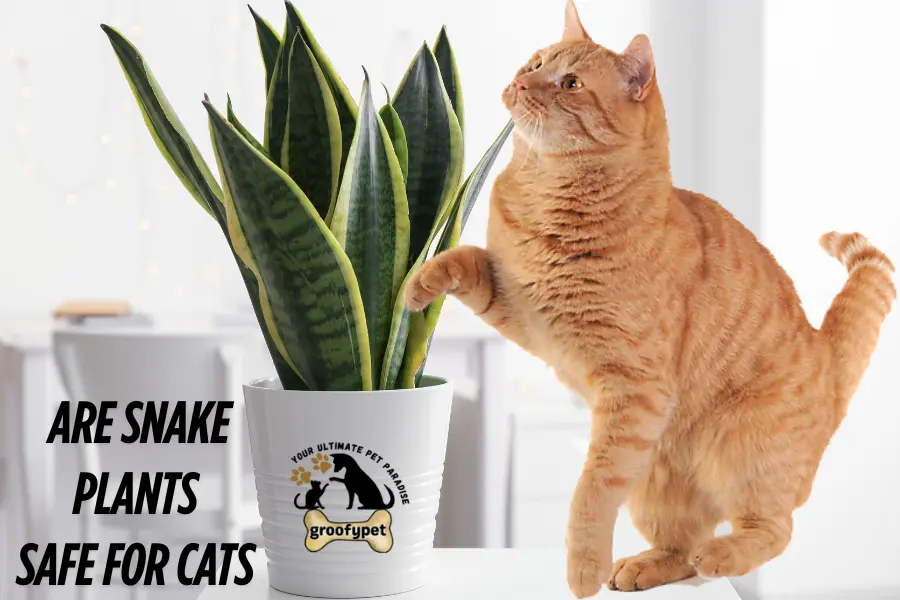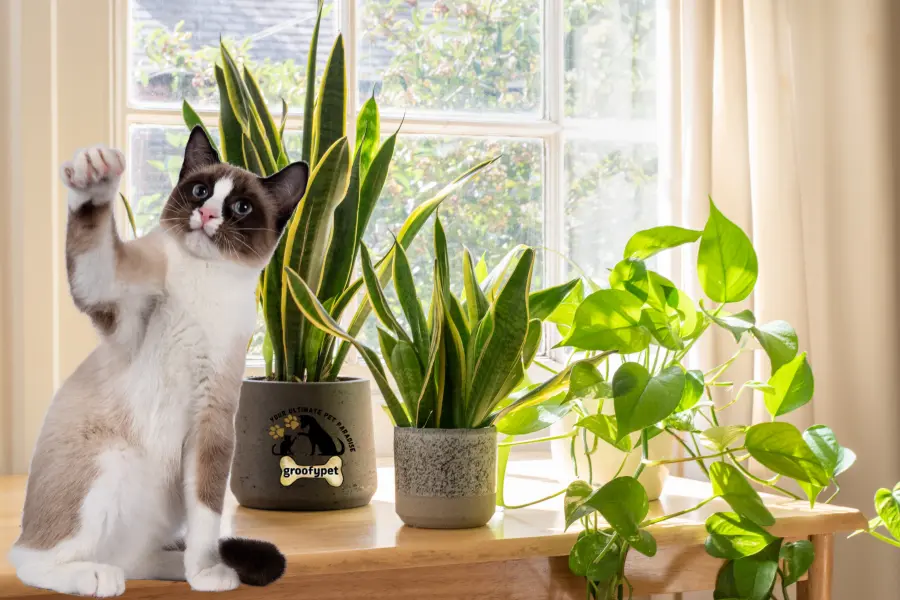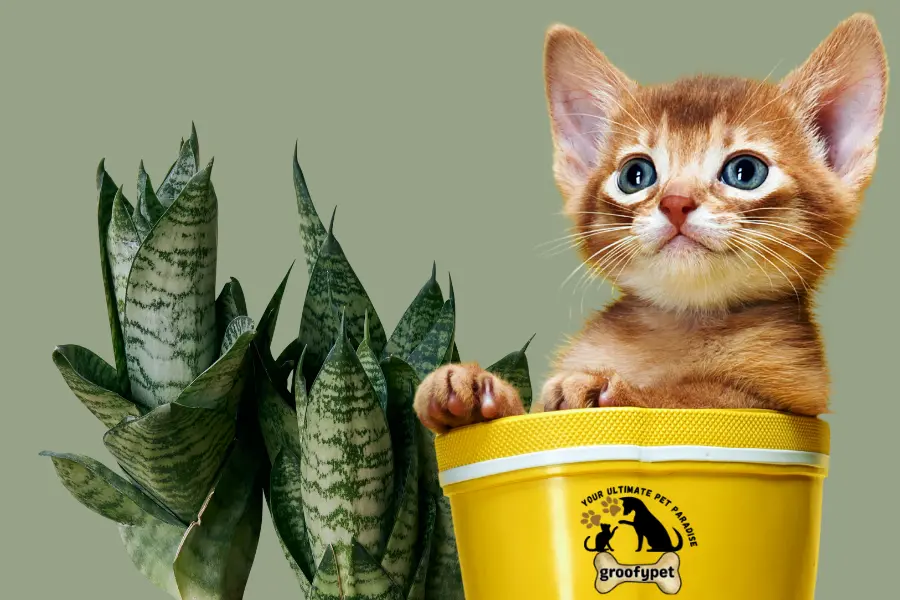
Are you curious about the reasons behind the toxicity of snake plants to cats, as well as the warning signs to watch out for? Keep reading—this information is essential for keeping your cat safe and healthy.
Snake plants, now classified under the Dracaena genus but formerly known as Sansevieria, include over 70 distinct species. Some of the most well-known and commonly grown types are These varieties differ in leaf shape, color, and pattern, making them favorites and outdoor plants safe for cats.
Table of Contents
ToggleAre snake plants safe for cats?
Snake plants are not safe for cats. They are toxic and can cause health problems if a cat chews or eats the leaves. The plant contains natural chemicals that protect it from pests, but these same chemicals are harmful to pets.
Even though snake plants look harmless, they can upset a cat’s stomach and cause other issues. So, if you are asking are snake plants safe for cats, the answer is no. It is better to keep them away from areas where your cat can reach them.
Why are snake plants toxic to cats?
Snake plants contain a substance called saponins. These are natural chemicals that help protect the plant from insects and fungi. When a cat eats snake plant leaves, the saponins can irritate the digestive system. This leads to problems like vomiting, drooling, and diarrhea.
Some cats may also feel pain in the stomach or become weak. While the toxin is usually mild, it can still make your cat feel very sick. Knowing why snake plants are toxic helps you understand why you should not let your cat near them.
Symptoms if a cat eats a snake plant
If your cat eats a snake plant, you may notice several signs.
- Common symptoms include vomiting, diarrhea, and drooling.
- Your cat may also stop eating because of nausea.
- Some cats become tired and do not want to play.
- They may show signs of stomach pain by curling up or avoiding movement.
- The symptoms usually start within a few hours after chewing the plant.
- While most cases are mild, they can still be very uncomfortable for your pet.
- It is always best to watch your cat closely and call the vet if you see these symptoms.
What to do if your cat eats a snake plant?
If you think your cat has chewed on a snake plant, do not panic.
- First, remove any pieces of the plant from your cat’s mouth.
- Rinse their mouth gently with clean water.
- Keep fresh water available to help flush the toxins out.
- Watch your cat for vomiting, diarrhea, or other unusual behavior.
- If the symptoms are strong or last for a long time, call your vet right away.
- The vet may give your cat medicine to stop vomiting or help with dehydration.
- Acting quickly can make a big difference.
How much snake plant is toxic to cats?
Even a small amount of snake plant can upset a cat’s stomach. Some cats may only lick the leaves and still feel sick. Larger bites usually cause stronger symptoms. The level of reaction can also depend on the size and age of the cat. Kittens may be at higher risk because they are small and more sensitive. No amount of snake plant is truly safe for cats. This is why you should not take chances and keep the plant out of reach. Prevention is always better than treatment.
Are snake plants safe for other pets?
Snake plants are not safe for many pets. Dogs can also get sick if they chew on the leaves. Rabbits and smaller pets like hamsters may have even stronger reactions because of their size. Just like cats, they may vomit or have diarrhea. If you have a multi-pet household, it is better to avoid snake plants altogether. There are many other pet-safe plants you can keep without worrying about your furry friends.
Snake plant indoor or outdoor
The snake plant, scientifically known as Sansevieria trifasciata, is one of nature’s most adaptable houseplants, surviving equally well both indoors and outdoors depending on your climate.
The snake plant is a fantastic choice whether you keep it inside your home or plant it in your garden. As a houseplant, it’s easy to care for – you only need to water it about once every week or two, and it can handle low-light areas like your bedroom or office.

The tall, thick leaves with their dark green and yellow stripes add a modern look to any room. If you live in a warm climate, you can also grow snake plants Whether you choose indoor or outdoor growing, the snake plant is a reliable, attractive plant that fits into any home.
Cat-safe alternatives to snake plants
There are many indoor plants that are safe for cats. Some good choices include areca palm, spider plant, parlor palm, and bamboo palm. These plants are non-toxic and add beauty to your home. They are also easy to care for, just like snake plants. If you want greenery without the risk, these are the best options. They also improve indoor air and create a fresh look. Choosing cat-safe alternatives helps you enjoy plants while keeping your pet safe and happy.
Do cats like to chew on snake plants
Cats are curious and often chew on plants out of boredom. Indoor cats especially like to nibble on leaves. The long upright leaves of a snake plant may attract them even more. Some cats chew because they want fiber, while others do it for fun. Sadly, this habit can lead to sickness if the plant is toxic. It is important to give your cat safe chew toys or even a pot of cat grass. This way, your cat can chew safely without touching harmful plants.
Recognizing Snake Plant Poisoning in Cats
How do you know if your cat has been affected by a snake plant? Common signs include nausea, vomiting, and diarrhea. You might also notice lethargy, loss of appetite, drooling, mouth or throat swelling, or signs of abdominal discomfort. The severity of symptoms can vary depending on how much of the plant was ingested and your cat’s sensitivity.
my cat ate snake plant but seems fine – should i worry
Sometimes a cat may chew a snake plant and not show any symptoms right away. But you should still be careful. The signs of poisoning can take a few hours to appear. Even if your cat looks fine, watch them closely for vomiting or drooling. If you are unsure, call your vet and explain what happened. It is always better to be safe. Do not wait until your cat gets worse. A quick check can save your cat from unnecessary pain.
are all types of snake plants toxic to cats
Yes, all types of snake plants are toxic to cats. Whether the leaves are tall, short, green, or striped, they all contain saponins. This means no variety is truly safe. Some people think certain kinds may be less harmful, but this is not true. Every snake plant has the same risk. If you want to grow plants with cats in the house, it is better to choose safe species. Do not trust myths about some being harmless.
Can snake plant water harm cats?
Some people wonder if water from snake plant pots is dangerous. The answer is yes, it can be. When you water a snake plant, small amounts of the toxins can mix into the soil and water. If your cat drinks from the pot, it may feel sick. This is why you should not let your cat drink any plant water. Always provide clean water in a separate bowl for your pet. Keeping your cat away from plant pots is a safe habit.
Why do cats chew on toxic plants?
Cats may chew on toxic plants for many reasons. They may like the texture of the leaves or enjoy the taste. Some cats chew because they are bored or stressed. Others chew because they lack fiber in their diet. Sadly, they do not know which plants are dangerous. This is why pet owners must step in and protect them. Giving your cat safe plants like catnip or cat grass can help. It satisfies their need to chew without risking their health.
How Is Snake Plant Toxicity Treated?
If you examine snake plant poisoning, your cat vet will assess your cat and start treatment according to its condition. Care often involves such things as IV fluids, dehydration, or anti-nausea medications to upset the cat’s stomach. In some cases, pain relief may be prescribed. Always seek veterinary help if your cat shows any symptoms.
Protecting Your Cat From Snake Plant Poisoning
If your cat is attacked by a snake plant, it’s only natural to want to prevent it from happening again. The good news is that a few simple changes can make a big difference in keeping your feline safe from further exposure to this toxic plant.
Remove the Snake Plant Safely
One of the easiest and most effective solutions is to remove the plant entirely. Since snake plants are visually appealing and easy to care for, consider gifting yours to a friend or family member who doesn’t have pets. This way, your cat won’t get another chance to nibble on its leaves, and the plant can still be appreciated in a safer environment.
Offer Safe Alternatives for Chewing and Playing
Cats are naturally curious and love to chew, so offering them safe, non-toxic alternatives can help redirect that behavior. Indoor cat grass is a great option—easy to grow and satisfying to chew. While the reasons cats eat grass aren’t fully understood, it seems to be an instinct.

Catnip toys are another way to mentally and physically engage your cat. A bored cat is more likely to explore and chew on harmful objects, so creating a stimulating environment with toys, scratchers, and safe plants can help reduce the risk of future problems.
Types of snake plant
- Black Diamond Snake Plant
- Dracaena patens
- La Rubia Snake Plant
- Futura Superba
- Zeylanica Snake Plant
- Robusta Snake Plant
- Sansevieria Moonshine
- Sansevieria hahnii
- Dracaena angolensis (Sansevieria cylindrica)
- Variegated Laurentii Snake Plant
- Twisted Sister
- Bantel’s Sensation
- Dracaena pearsonii
Benefits of Snake Plant
The snake plant, also called mother-in-law’s tongue, is a stylish houseplant that brings a range of health and wellness benefits. Not only does it help to purify indoor air by removing harmful toxins, but it also enhances health.
By releasing moisture and oxygen, it can reduce airborne allergens, making the air fresh and easy to breathe. People believe that it helps absorb negative energy, creating a more balanced and peaceful environment at home and are cat friendly outdoor plants.
Symptoms of Snake Plant Toxicity in Cats: What Happens If Your Cat Eats a Snake Plant?
If your cat eats a snake plant, it will show symptoms of toxicity. Look for signs like
- Dilated pupils
- Depression
- Abdominal discomfort or pain
- Drooling
- Pale gums
- Lethargy
- Nausea
- Vomiting
- Swollen throat or mouth
- Loss of appetite
Are Snake Plants Safe for Cats? If not, what to do?
Are snake plants safe for cats ? If your cat eats a snake plant, it’s important to act quickly to keep them safe. Start by removing the plant from their reach or an inaccessible area. Next, contact your veterinarian right away or call a pet poison control center. It depends on the situation, including any symptoms your cat is showing, so they can guide you based on the specifics of the situation.
Also Read : Can cats drink coconut water?

Keep watch on your cat and look for signs like vomiting, diarrhea, lethargy, or loss of appetite. If you can, bring a sample of the plant to the vet—this can help confirm the identity and determine the best treatment plan.
To prevent your pet from eating a snake plant, focus on making your home pet-safe by using a few simple strategies.
How to keep cat away from snake plant?
Keep plants out of reach by placing your snake plant on hanging planters or isolated stands where your pet can’t access them. You can also move the plant to a room or enclosed space your pet can’t enter. Use safe deterrents like tasting sprays designed for pets. Provide safe alternatives, such as pet-friendly grass chew toys, to your cat as alternatives.
Are snake plants toxic to humans?
Generally, snake plants are low-risk for humans, but ingesting the leaves may lead to discomfort like mouth irritation or nausea. It is important to avoid direct contact with the eyes and to seek medical advice in certain conditions.
Are All Snake Plant Varieties Toxic to Cats and Dogs?
Yes, all snake plant types—including those classified under Sansevieria and Dracaena—contain saponins, which are toxic to both cats and dogs when ingested. To keep your pets safe, avoid placing these plants where they can reach them, including outdoor areas if your pets roam freely.
How Do I Know If My Pet Ate a Snake Plant?
Signs of ingestion include vomiting, diarrhea, sluggishness, and reduced appetite. If you notice any of these symptoms and suspect your pet may have chewed on a snake plant, contact your vet immediately. Try to give as much detail as possible, including the plant type and your pet’s behavior.
Frequently Asked Questions
Yes. Mother-in-law’s tongue, another name for the snake plant, is also toxic to rabbits due to its harmful chemicals. It’s best to keep this plant entirely out of areas.
Final thoughts
Keeping snake plants in your home brings charm and air-purifying benefits, but their toxicity to pets requires awareness and precautions. Are snake plants safe for cats ? Knowing the signs of ingestion, acting quickly with veterinary help, and taking steps to prevent access help maintain a safe and peaceful environment. Keeping plant care with pet safety, you can create a space where the presence of snake plants adds to the health and happiness of your furry companions.
How Much Should My Cat Eat? A Guide to Keeping Your Feline Healthy
Can Cats Eat Shrimp? A Surprising Way to Pamper Your Pet!



